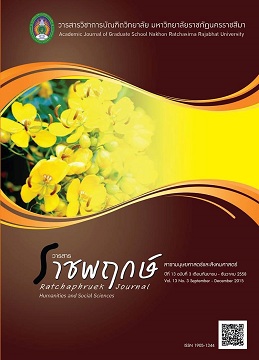ปัจจัยที่มีความสัมพันธ์กับพฤติกรรมการป้องกันอันตราย จากสารเคมีกำจัดศัตรูพืชของชาวบ้านตำบลท่าหินโงม อำเภอเมือง จังหวัดชัยภู
Main Article Content
Abstract
การวิจัยเชิงวิเคราะห์แบบภาคตัดขวางครั้งนี้ มีวัตถุประสงค์เพื่อศึกษาปัจจัยที่มีความสัมพันธ์กับพฤติกรรมการป้องกันอันตรายจากสารเคมีกำจัดศัตรูพืชของชาวบ้าน ตำบลท่าหินโงม อำเภอเมือง จังหวัดชัยภูมิ เก็บรวบรวมข้อมูลโดยใช้แบบสัมภาษณ์จากกลุ่มตัวอย่างจำนวน 200 คน ใช้วิธีสุ่มแบบบังเอิญ วิเคราะห์ข้อมูลโดยใช้สถิติเชิงพรรณนา ได้แก่ ค่าความถี่ ร้อยละ ค่าเฉลี่ย ส่วนเบี่ยงเบนมาตรฐาน และสถิติเชิงอนุมาน ได้แก่ การวิเคราะห์ช่วงความเชื่อมั่น 95% ของร้อยละ การวิเคราะห์วิเคราะห์ถดถอยพหุลอจีสติก นำเสนอค่าขนาดความสัมพันธ์ด้วย Adjusted Odds Ratio และช่วงความเชื่อมั่น 95%
ผลการวิจัย พบว่า กลุ่มตัวอย่างทั้งหมดใช้สารกำจัดศัตรูพืช และส่วนใหญ่มีพฤติกรรมการป้องกันอันตรายจากการใช้สารเคมีกำจัดศัตรูพืชที่เหมาะสม ร้อยละ 65.5 (95% CI: 58.5- 72.1) มีความรู้ในระดับปานกลาง ร้อยละ 48.5 (95% CI: 41.4-55.6) การรับรู้เกี่ยวกับอันตรายจากสารเคมีกำจัดศัตรูพืช ระดับปานกลาง ร้อยละ 59.0 (95% CI: 51.8-65.8) ปัจจัยเอื้อต่อการใช้สารเคมีกำจัดศัตรูพืช คือ ความสะดวกในการจัดซื้อจัดหา ร้อยละ 98.0 โดยซื้อจากร้านค้าในชุมชนมากที่สุด ร้อยละ 74.5 ส่วนใหญ่มีอุปกรณ์ในการป้องกันอันตราย ร้อยละ 88.0 และได้รับข้อมูลข่าวสารเกี่ยวกับสารเคมีกำจัดศัตรูพืช ร้อยละ 78.0 ด้านปัจจัยเสริม พบว่าร้อยละ 56.5 ของกลุ่มตัวอย่างไม่มีภาคีเครือข่ายสุขภาพ ปัญหาด้านสุขภาพที่เกิดจากการใช้สารเคมีกำจัดศัตรูพืชในรอบ 6 เดือนที่ผ่านมา พบว่า กลุ่มตัวอย่าง ร้อยละ 49.0 เคยมีอาการเจ็บป่วย เช่น ปวดหัว คลื่นไส้ อาเจียน มือสั่น เป็นต้น
ปัจจัยที่มีความสัมพันธ์กับพฤติกรรมการป้องกันอันตรายจากการใช้สารเคมีกำจัดศัตรูพืชโดยการวิเคราะห์หลายตัวแปร ไม่พบความสัมพันธ์ระหว่างปัจจัยต่างๆ กับพฤติกรรมการป้องกันอันตรายจากการใช้สารเคมีกำจัดศัตรูพืช
Factors Related to Hazard preventive Behavior on Chemical Pesticide Use of People in Tahin-Ngom, Muang, Chaiyaphum
The purpose of this cross-sectional analytical study was to identify the factors related to hazard preventive behavior on chemical pesticide use among people in Tahin-ngom, Muang, Chaiyaphum. 200 samples were recruited by using accidental sampling. The research data were collected by the interview and analyzed by using descriptive statistical analysis, such as frequency, percentage, mean, standard deviation and Inferential statistical analysis. Confidence Interval and Multiple logistic regression presented magnitude of effect by Adjusted Odds Ratio and 95% Confidence Interval.
The results showed that all sample used to chemical pesticide. The majority had appropriate hazard preventive behavior on chemical pesticide use (65.5%; 95% CI: 58.5-72.1), knowledge was found in moderate level at 48.5% (95% CI: 41.4-55.6) and perception of hazard preventive behavior was found in moderate level at 59.0% (95% CI: 51.8-65.8). Enabling factors contributing to the chemical pesticides use was facility of purchase 98.0%. Mostly, they were bought from the stores in communities 74.5%. Besides, most of them had preventive equipment of 88.0% and receiving the information of 78.0%. For the reinforcing factors found that 56.5% of the samples had no health networking. In addition, health problems which occurred in the past six months found that its 49.0% had an illness due to chemical pesticides use such as headache, nausea, vomiting, tremor and so on.
The result of multivariate analysis showed that there was no significant correlation between the various factors and the hazard preventive behavior on chemical pesticide use.


